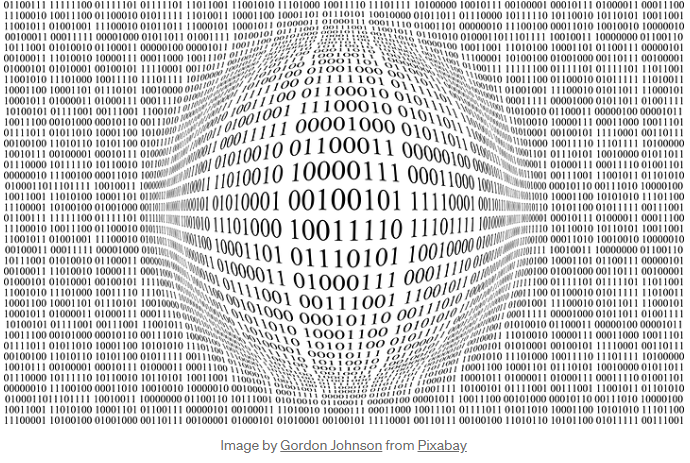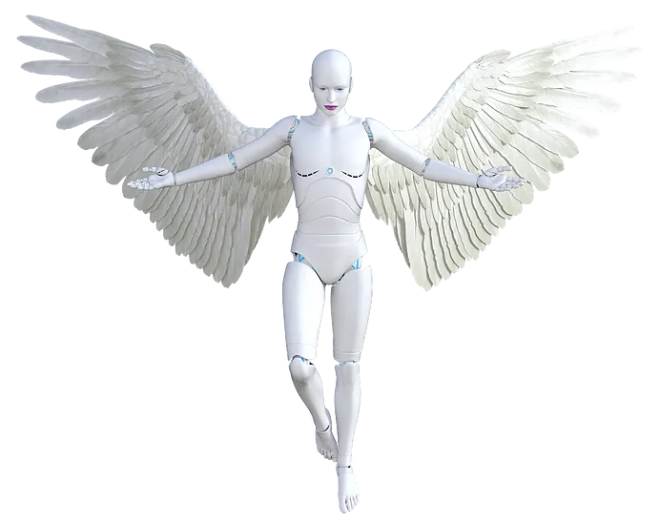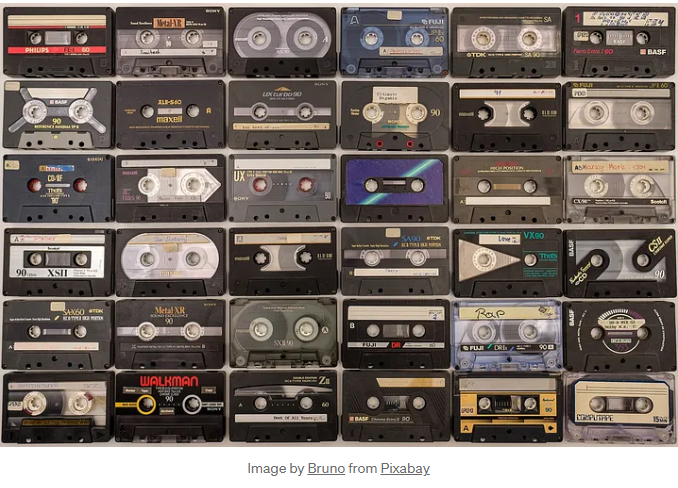Thank you to Kem-Laurin Lubin, PH.D - C for sharing her knowledge and expertise with us.
You can read this article on Medium as well.

“Cyborgs are not reverent; they do not remember the cosmos.” — Donna Haraway
Lately, I’ve been grappling with a sense of unease when it comes to engaging on social platforms. It feels like with each passing day, we’re pushed into residing within the echo chambers that we’ve collectively constructed — you’re either in this camp or that one, and having ideas that exist in the spaces in between often results in a barrage of comments from opposing sides. The heightened political division that we’re witnessing is eerily similar to the black-and-white dichotomies in our digital age. Just as our social media timelines transform into battlegrounds, polarizing individuals into distinct left or right camps, the world of computing offers a parallel.
Remember the early days of digital media, when we’d have to pick sides between VHS and Betamax, You’re either team Jennifer or team Angelina, the good guy or the bad guy, or in our more modern era, between Android and iPhone? Perhaps there was never a hope for Blackberry, after all — but I digress. Similarly, in the international arena, the Israel-Palestinian conflict has increasingly been framed as an either-or situation, with many feeling the pressured to staunchly support one side, leaving little room for nuanced discourse or understanding the complexities of the issue.
Such binary perspectives not only simplify complex matters but also rob us of the opportunity to appreciate the richness of diverse viewpoints and to find middle ground. While I can extend this blog to include deeper philosophical views on the wider theme of binary thinking, it would be remiss of me to not preface the rest of this blog by not invoking the works of Friedrich Nietzsche. In his exploration of morality, Nietzsche challenged the traditional binary of good and evil, suggesting that such distinctions are often used to further specific interests rather than any inherent righteousness. His deconstruction of master-slave morality further emphasizes the danger of simplifying complex human motivations into clear-cut categories and is the perfect bridge to frame our current predicament as users of social media, in our failing techno-culture.
No room for greys: The absence of in-betweens
Today, many are experiencing an increasing sense of apathy and disconnection from the core elements that define our humanity. In an effort to conserve my energy, I sometimes find myself momentarily slipping into a “Stepford Wife mode,” where I put on a facade that “everything is okay,” even though beneath the surface, there’s a silent scream for a collective awakening of our shared humanity, reminding us not to lose ourselves in the transitory nature of our existence.
For those who have known me or followed my journey, you’re likely aware that I hail from the vibrant world of the “French Creole Antilles.” There, thoughts flowed freely without self-censorship, and the joy of life reigned supreme. However, today, as a resident citizen of Canada, a “bastion” of Western morality, I find that this innate aspect of my identity has undergone a transformation. Recently, I’ve felt an unsettling change in daily interactions, almost as if stepping into a world where people echo mechanistic tones. There’s a growing urgency to align with causes presenting just two options. Yet, beneath these binary stances lie deep lineages and archaeologies of thought, reminiscent of Michel Foucault’s exploration of histories, which now sculpt our transforming reality.

Image by Pete Linforth from Pixabay
In light of this transformation, and in my daily experiences, I’ve been drawn to the thought-provoking ideas presented by Donna Haraway. Haraway is best known for her book, Simians, Cyborgs, and Women: The Reinvention of Nature, in which she presents her influential essay “A Cyborg Manifesto.” Her work delves into the relationship between (more appropriately, among) technology, gender, and identity, challenging conventional notions and advocating for a post-gender world.
Haraway also explores the evolving nature of humanity in an age where technology and biology converge, blurring the lines between human and machine. Her work challenges us to reconsider what it means to be human in a world where the boundaries between the natural and the artificial are increasingly blurred, offering insights into the very essence of our existence and the implications of this “brave new world.” Building on Haraway’s intriguing concepts, I posit that we’ve journeyed beyond merely being post-human or fully integrated cyborgs. On this self-charted course, we’re gradually relinquishing our grasp on nuanced perspectives. Much like cyborgs operating in binary code, our views are becoming polarized — we’re increasingly pressured to be a ‘1’ or a ‘0’, with little room for the shades in between, and goaded by the panopticon of the algorithms.
Humanities will save the world
As a student of the Humanities, deeply informed and rooted by the intricate tapestries of human narratives, I find myself standing at the crossroads of tradition and transformation. The gradations of human stories, once celebrated for their nuances, now seem to be at odds with the stark binary language of our machine-driven era. It’s a poignant dichotomy that drives home the urgency to address the seismic shift in our communication patterns. How we share, express, and preserve our shared humanity amidst the relentless march of technology becomes a question not just of adaptation, but of preservation and evolution.
But how did we get here?
The binary system of thought
Throughout intellectual history, the binary system of thought has played a pivotal role both as a fundamental construct and a subject of scrutiny. Claude Lévi-Strauss, the anthropologist, believed that humans inherently classify thought into binary oppositions, such as life/death and raw/cooked. Yet this was not without its challengers. Philosophers like Jacques Derrida peeled back these layers, highlighting the constructed essence of such binaries through deconstruction. In the realm of feminist theory, voices like Simone de Beauvoir and Judith Butler confronted and deconstructed gendered binaries like male/female. The art world wasn’t untouched by this binary thought paradigm, as seen in the vanitas movement, which poignantly juxtaposed life’s vibrancy, often symbolized by flowers, with the inevitable reality of death, often represented by skeletons.
Donna Haraway, of course, took the idea of the binary into the realms of the digital and postmodern, drawing connections with cybernetics and our evolving symbiosis with technology. While the West has occasionally been critiqued for its penchant for binaries, Eastern philosophies, such as Taoism, offer a different perspective, celebrating concepts like yin and yang that signify interconnected dualities rather than stark oppositions. And in the discourse of postcolonial studies, luminaries like Edward Said laid bare the binaries such as West vs. East, underscoring their roles in perpetuating power hierarchies.
The oscillation between dualities in intellectual history and art, as well as the critiques against them, have contemporary echoes in a realm we interact with daily — social media. These dualities find a pronounced manifestation in the digital world we inhabit. Computing systems, including computers, smartphones, and the internet, are fundamentally built upon binary logic. All digital information is distilled down to combinations of 0s and 1s. Such an approach is by nature simplistic and reductionist, compressing intricate real-world phenomena into discrete, binary choices. Here are just a few examples to illustrate how this manifests in our daily lives, and you can make your own extrapolations to thinking about other recent examples, often with potent socio-political consequences.
On-Off Thinking
Imagine reading a news article about a complex issue like climate change. Instead of delving into the intricacies of the problem, the nuances of solutions, and the myriad of stakeholder opinions, readers often fall prey to binary simplifications. “Is climate change real or a hoax?” This reductionist thinking overlooks the extensive research, the gradations of impact in different regions, and the spectrum of proposed solutions. This is analogous to flipping a switch to either “believe” or “disbelieve,” missing the intricate tapestry of information in between.
Binary Choices
Consider the reactions to a heartfelt post on social media, and we can mostly all attest to this scenario, where someone shares their experience with mental health struggles. The content is deep, personal, and multifaceted, but the platform’s design primarily allows for binary responses: “like” or “dislike.” I will acknowledge, here, that the social media platform, LinkedIn has perhaps, had this same degree of reflection, as I have had and in the recent years has “reaction” emojis to reflect a broader spectrum of reactions options; these include: like, love, support, insightful and celebrate. I commend this change.

Such a system might fail to capture the depth of empathy, concern, or even the need for more information. Users might feel compelled to oversimplify their reactions, potentially polarizing views, and undermining the complexity of the topic.
Digital Divides
Let’s think about a more personal story of classroom scenario, in a course I recently taught on Information Design. While my example was group work, I will, for simplicity, reduce it to a story about two students.
Two students are given a task to create a presentation. Student A, having grown up with excess and access to various digital tools and resources, quickly assembles a visually appealing presentation with embedded videos and interactive elements. Student B, who may only have had sporadic access to computers, creates a basic slideshow, using Microsoft, PowerPoint. Observers might hastily label Student A as “tech-savvy” and Student B as “tech-illiterate.” This binary labeling ignores the possibility that Student B might have other digital skills, like coding or digital artistry, or even that they might have a deeper understanding of the topic at hand but just lacked the tools to express it in that format. And, this is where we begin the tragic descent into our fading appreciation for analogue expressions.
From analogue to digital

In the digital world, information is encoded as discrete, binary digits, commonly known as bits. These bits can only have two states: 0 or 1. This fundamental duality is at the heart of computing and has profound implications for human thought. The ripple effects of computing’s binary logic are evident not just in technological realms but deeply embedded within the tapestry of human culture, and facilitated by tech giants via the designs on “social” media platforms. This can be seen in a number of examples that I will delve more into here:
Polarization in discourse
A glaring manifestation of binary thinking is the heightened polarization seen in political, social, and cultural arenas. Issues like climate change or gun control, abortion, sexual identity, which intrinsically demand multifaceted analysis, are often distilled into binary standpoints: you’re either a believer or a skeptic, pro-gun or anti-gun, pro-life or anti-life, pro-trans rights or anti trans rights, and so on. These oversimplification fosters extreme views, stagnating meaningful dialogue and leaving little room for middle ground.
The quest for the immediate
Our digital epoch has amplified a culture valuing immediacy, pushing us towards swift and mindless binary choices. Remember the days of leisurely bookstore visits, where we’d sift through pages before a purchase? Today, a quick online review or rating can dictate our choices. Such a paradigmatic shift in our human existence, might be eroding our capacity for reflection, patience, understanding and the appreciation of subtleties.
The shadows of algorithmic decision-making
If you have followed my academic research, I focus on AI and computational rhetoric, where I explore the construction of digital identities — you can read a recent blog post, “The perils of AI: How artificial intelligence constructs human identity to their detriment.” As the title suggests, here, I explore the perils of allowing technology to construct, at best as an effigy of our analogue form.
Algorithms, deeply rooted in binary logic, now steer myriad facets of our online interactions — from the ads we see to potential romantic partners on dating apps. Yet, their binary underpinnings can sometimes be blind to human intricacies. For instance, job recruiting algorithms might inadvertently favor certain demographics over others, or music recommendation systems might pigeonhole us into singular genres, bypassing the rich eclecticism of our tastes, or recommendation engines, knowing your ethnicity or race, may only present you with options that reflect your constructed digital identity.
Sidebar: Harmonies, algorithms, and a kitchen jukebox: An AI’s intimate concert
In an amusing twist of domesticity, my partner and I share stewardship of a rather antiquated mobile device, which, in its dignified retirement, serves diligently as our designated ‘kitchen symphonist’. Through the modern magic of Bluetooth connectivity, and Internet connection to YouTube, this device serenades us with melodies as we indulge in the culinary arts. Our musical predilections, though harmoniously overlapping in the realms of reggae, the evocative strains of 80s and 90s rap, triphop, and the rebellious echoes of punk, seem to be distinctly discernible to the AI within our device.
As I immerse myself in the rich rhythms of Creole legends like Kassav, (yes legends!!!) or the vibrant pulse of Afro beats, the device, almost clairvoyantly, curates a playlist that mirrors my inclinations. Yet, in moments of delightful unpredictability, my partner’s penchant for rock will interlude, prompting a swift recalibration of the AI’s chosen tracks. It’s a dance of algorithms and affinities, an intersection of technology and taste. And in this interplay, the AI emerges not just as a tool, but as an astute observer of our shared and individual musical narratives.
And in my punchy humour I remind my partner that sooner or later, the AI will be reminded that The White Stripes, The Black Keys, and The Rolling Stones are the default setting — a dig at his whiteness and the idea of white patriarchy. Nonetheless, by acknowledging these resonances, we become better equipped to navigate a world increasingly molded by binary thought while advocating for the preservation of our human complexities.
At the edge of humanity: Resisting the digital abyss
If we do not actively seek to preserve our collective humanity from the ever-widening panopticon of unchecked technology, we stand at the precipice of an unwelcome future. In this looming dystopia, our richest emotions, deepest connections, and the very nuances that define our humanity could be eclipsed by the cold efficiency of algorithms. We risk becoming mere data points in an expansive digital realm, losing the profound tapestry of human experience to the binary simplicity of ones and zeros. The need of the hour is not just resistance but a conscious reclaiming: of our stories, our agency, and our shared soul. For in the absence of this introspection and action, we may find ourselves inhabiting a world where the heartbeat of humanity is drowned out by the hum of machines.
About me: *Hello, my name is Kem-Laurin, and I am one half of the co-founding team of Human Tech Futures. I am currently pursuing a doctoral degree at the University of Waterloo. My research inquires into identity construction through contemporary case studies (judicial) that demonstrate how citizens’ data is collected and utilized. Whether data is illicitly harvested or willingly shared, the resultant algorithmic constructions wield immense power over users whose identities are quantified through information. My research objectives are to (1) develop a critical understanding that will then allow me to (2) produce concrete heuristic principles for use in AI powered design systems (as informed by my professional experience in systems design).
Professionally I practice as a Principal HCD Strategist and Design Thinking Coach. Prior, I led both small and large Design and Research teams at Blackberry Autodesk and also worked at Siemens in both Munich, German, Princeton, USA. In my spare time, I build layered gardens with a tropical vibe while my 135 pound GSD looks on. Today I feel blessed to have traveled to over 25 countries before the world transformed to what it is today; I was able to experience a good breadth of human experiences. Periodically, I give back as an active mentor to my students, and many burgeoning critically thinking HCD Researchers who seek to make the world a better place.*